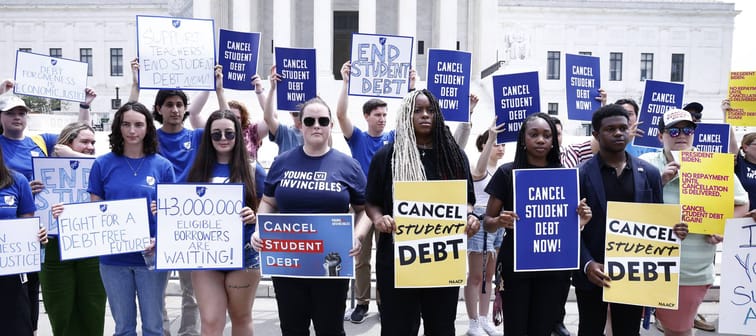Millions face growing debt obligations
Millions of Americans collectively owe $1.6 trillion in student loans, according to the Federal Reserve Bank of New York. And borrowers under age 40 owe 55% of that total debt, according to the Education Data Initiative
“Millennials like me have gone through so many economic crises and watched these corporations and banks get bailed out,” said Amanda Acevedo, a 37-year-old radiographer from Orlando, in a recent interview with Bloomberg. “Meanwhile, we can’t pay the student loans we were told we needed for success.”
Acevedo used the loan repayment pause to save up for a down payment on a house. Now the mother of three is expected to pay back $412 every month towards her student loans.
The Education Data initiative also reported that the average federal student loan borrower has $37,338 outstanding, and the average private debt is $54,921 per borrower.
Meanwhile, many borrowers are generally in worse shape to repay these loans than before the start of the temporary repayment pause, which the Department of Education implemented in 2020 in the early days of the COVID-19 pandemic.
Since then, amid a high cost of living and rising interest rates, borrowers have built up other forms of increasingly costly debt, such as mortgages, auto loans and personal loans.
Last year, the Consumer Financial Protection Bureau (CFPB) identified five risk factors that could lead to student loan borrowers struggling to repay their debt to the point of debt delinquency — and one of those factors is the rate of delinquency on non-student debt since the start of the pandemic.
According to a June CFPB report, about 2.5 million student loan borrowers had at least one delinquent non-student loan as of March of this year, an increase of around 200,000 borrowers since September 2022.
For those likely to resume student loan repayment, the median monthly payments on these non-student debt obligations have increased by 24%. Younger borrowers were hit especially hard as they saw an increase of as much as 252% in their median monthly payments, from $65 to $229.
Discover how a simple decision today could lead to an extra $1.3 million in retirement
Learn how you can set yourself up for a more prosperous future by exploring why so many people who work with financial advisors retire with more wealth.
Discover the full story and see how you could be on the path to an extra $1.3 million in retirement.
Read MorePossible consequences for not resuming repayment
Borrowers who choose to participate in a protest or otherwise fail to make payments could face severe financial consequences.
For one thing, withholding repayment could make a typical student loan much more expensive in the long run, given that the interest would eventually start to stack up.
In some circumstances, lenders can even garnish up to 15% of the borrower’s wages to repay loans in default. And 19 states have laws that can suspend or even revoke delinquent borrowers’ professional licenses, affecting those with occupations such as firefighter, nurse, teacher, lawyer, and even barber.
The government can also withold Social Security benefits, which could impact the finances of the millions of borrowers over the age of 62 who have an average outstanding student debt of $41,778. Also, about 23% of that $1.6 trillion of total debt is held by borrowers over the age of 50
The way forward
In 2022, the Biden administration made moves to forgive up to $20,000 in student loans for most borrowers, but the Supreme Court ruled against the proposal in June.
Nevertheless, the administration appears determined to provide some relief.
Biden has now implemented a year-long leniency program that shields borrowers from the worst consequences of not repaying their student loans.
Under the plan, borrowers will have some breathing room. Those who fail to make repayments from Oct. 1, 2023, to Sept. 30, 2024, won’t be placed in default or considered delinquent by credit bureaus.
Private loan borrowers might have the option to refinance their loans ahead of repayment restart in October.
For those with government loans, the Biden administration has also created the Saving on a Valuable Education (SAVE) plan, which offers borrowers reduced monthly payments — calculated according to their income and family size — and prevents unpaid interest from increasing loan balances.
The measures could save the average borrower up to $1,000 a year, according to government estimates. Even better, some SAVE loans can be forgiven entirely after 10 years’ worth of qualifying payments.
For their part, about 71% of the Intelligent.com survey respondents say they have taken or plan to take on extra work in preparation for payments resuming.
— With files from Samantha Emann, Moneywise senior associate editor
This 2 minute move could knock $500/year off your car insurance in 2024
OfficialCarInsurance.com lets you compare quotes from trusted brands, such as Progressive, Allstate and GEICO to make sure you're getting the best deal.
You can switch to a more affordable auto insurance option in 2 minutes by providing some information about yourself and your vehicle and choosing from their tailor-made results. Find offers as low as $29 a month.







